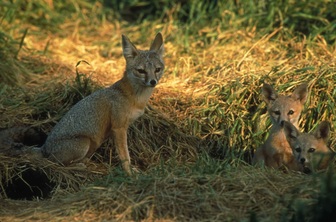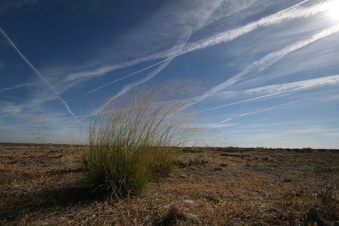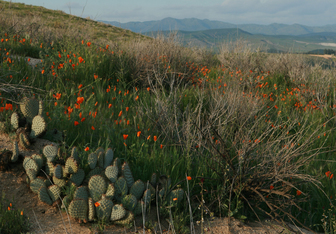"One Watershed" Series
|
#4 Why Should We Care
About Native Lands?
July 29, 2015
 San Joaquin Valley Kit Fox family (Source: Wikimedia Commons) San Joaquin Valley Kit Fox family (Source: Wikimedia Commons)
Very little of the Tulare Basin’s native valley floor habitat remains. Many in the conservation community claim that about 90-95% of the region’s native landscape has been converted to other uses, namely agriculture and urban use. This is among the highest rates of conversion in California.
When we convert land to other uses, we make economic gains but we lose the natural benefits provided to us by the land (“ecosystem benefits”). Rob Hansen, biology professor at the College of the Sequoias, put it this way: “We need to give nature credit for what it provides to us. The fertility of this land came to us via nature’s processes. We need to find balance and work with nature to provide those services again.” With so little native habitat remaining, finding balance isn’t easy. The Tulare Basin is facing a “real triage mode” of conservation, according to Larry Saslaw, retired wildlife biologist for the Bureau of Land Management. Two of the most significant impacts of land conversion include decreasing biodiversity (habitat and native seedbank) and shrinking groundwater supplies.  Alkali sacaton at Pixley National Wildlife Reserve (by Steve Laymon) Alkali sacaton at Pixley National Wildlife Reserve (by Steve Laymon)
The California Department of Fish and Wildlife works to protect the few remaining areas of untouched native valley floor. Erin Tennant, Environmental Scientist with the Department, believes that we need to advocate for “incentives to leave native habitat native.”
Despite the role of the Endangered Species Act, the valley is still experiencing a net loss of native habitat. Commercial and residential development projects go through state and federal permitting processes that require developers to mitigate for habitat losses. Agricultural development, however, does not generally trigger those permitting processes, creating a murky relationship between species protection and agricultural expansion. Meanwhile, thousands of wells in rural communities are going dry. As of July 28, 2015, Tulare County reported 1,491 domestic well failures. Additionally, many rural communities are dealing with water quality issues, rendering what little water they have undrinkable. According to Jenny Rempel at Community Water Center, a big part of the problem is inadequate oversight of water transfers and well drilling. The drought, of course, makes matters worse. The recently passed Sustainable Groundwater Management Act (SGMA) intends to bring groundwater supply and demand into better balance. Groundwater Sustainability Agencies are forming across the state to address persistent overdraft problems. The Tulare Basin’s overdraft levels are among California’s worst. At this time, no one can predict the means to achieve groundwater sustainability in this arid valley, but most agree that land use patterns are sure to change. Dick Moss, Vice President at Provost & Pritchard Engineering Consultants predicts that we’ll have to take about half a million acres out of production. “It’s not going to be fun or cheap,” he said. Complicating the situation is the fact that demand for agricultural land is high. The economics of farming – especially nut crops like almonds and pistachios – are undeniably lucrative. And converse to other areas of California, the Tulare Basin has more farmland than water to farm it.  Cactus and poppies in Bakersfield (by Steve Laymon) Cactus and poppies in Bakersfield (by Steve Laymon)
While the SGMA pushes the region to consider ways to decrease its dependence upon groundwater, economics is persuading farmers to expand their operations.
The forces of supply and demand always seek equilibrium, but equilibrium can be skewed when we fail to calculate the impact of those forces, something like a z-factor for sustainability. In this case, the z-factor is the long-term availability of groundwater supplies and the ecosystem benefits provided by native landscapes. As the Tulare Basin moves toward the SGMA-imposed goal of sustainability, it will need to consider ways to reduce water demand. Conservation of native lands and retirement of farmland are two solutions that provide multiple benefits including wildlife habitat, recreation opportunities, groundwater recharge, and flood control. The City of Bakersfield employs a successful model of land conservation. The Bakersfield Metro Habitat Conservation Plan (HCP), which offsets the effects of development, has conserved more than 22,000 acres. The HCP was one of the first in the country, established in 1994. Pamela Elisheva, Associate Planner for the City of Bakersfield, said that the HCP has not only been successful for native land conservation, and it’s also been “successful for the development community. It’s cultivated a consciousness to care about the land and the species.” Bakersfield is currently working with Kern County on the new 30-year Bakersfield HCP and the County is working on the Valley Floor HCP covering Western Kern County. “We’d like to have a long-term system in place to purchase habitat,” said Elisheva. HCP conservation can be augmented by land retirement, especially to connect tracts of land for species. Saslaw explained that conservation is more than “conserving the best of what’s left. The connection piece is important. That’s why land retirement is so important,” he said. Tennant underscored the need to retire farmland. “In order for our ecological reserves to be sustainable in the long run,” she said, “we spend a lot of time thinking about corridors and connections and the potential of land retirement to facilitate those connections between existing reserves." The Atwell Island Project, managed by the Bureau of Land Management, is a model for restoring retired farmland. With the help of many others, “we’ve developed a cookbook for land restoration,” said Jihadda Govan, Project Manager of Atwell Island. “It depends upon soil, rainfall, and weeds, but we’ve got it figured out,” she said. Several agencies – the USDA Natural Resources Conservation Service, the Bureau of Reclamation, and California’s Department of Water Resources – offer programs to help farmers with funding for land retirement and ongoing technical assistance. Places like Atwell Island shine a spotlight on the value and beauty of the Valley’s native landscapes, both its uplands and wetlands. With good planning, conservation and restoration of native lands can generate economic benefits as well. We have an opportunity to write a history for our children that looks back at our efforts, today, to create a better balance tomorrow. Authored by Niki Woodard, Communications Specialist for the Tulare Basin Wildlife Partners, who has been working with various land conservation and watershed health initiatives in the San Joaquin Valley for the past seven years.
|
Mission: To raise awareness about the Tulare Lake Watershed and its unique attributes, challenges, and opportunities. From the snowy peaks to the valley floor, we are one watershed.
This project is made possible by grant funding from the Fresno Regional Foundation.
This project is part of the Tulare Basin Watershed Initiative.
HELPFUL LINKS:
Other articles
|




